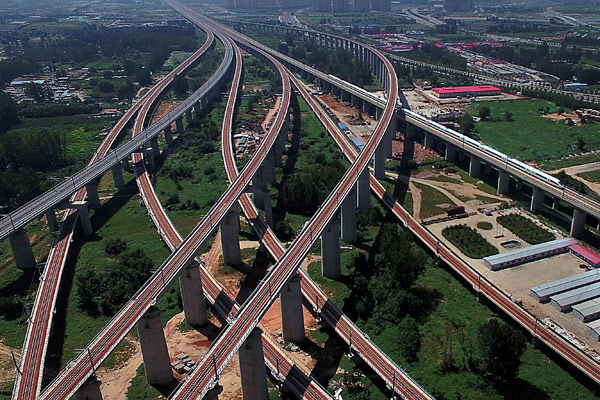Belt and Road Initiative looks beyond infrastructure
The Belt and Road Initiative is generating a symphony of development worldwide. The Belt and Road Forum for International Cooperation held in Beijing in May, and attended by more than 1,500 representatives from 130 countries and regions, achieved 270 deliverables.
|
High-speed railways crisscross near the Zhengzhou East Station in Central China's Henan province. [Photo/Xinhua] |
The Mombasa-Nairobi Standard Gauge Railway in Kenya, which opened on May 31, is also a fruit of the Belt and Road Initiative, as China loaned nearly 90 percent of the construction cost to Kenya and helped build the 480-kilometer railway in four years.
Overshadowed by the lack of fairness, openness, inclusiveness and public goods over the past few years, global governance needs fresh engines and more inclusive developmental mechanisms.
The initiative's developmental finance, for example, comes with both financial services and institutional guidance to complement the market economy of some countries. High on the agenda of the initiative, infrastructure is sought after by a slew of developing countries aspiring for industrialization. China's success in lifting 700 million people out of poverty in about four decades is also a key inspiration for those countries participating in the initiative.
Setting rules is no doubt necessary, but China has another important lesson to offer: development does not have a fixed pattern. Uzbekistan and Indonesia would not have received considerable infrastructure loans had it not been for China's State-owned banks. Their request for loans would have been rejected by other banks because international financial "norms" say so.
China's infrastructure plans, such as building high-speed railways, have been criticized by some Western observers for their high construction costs which could take years even decades to be recovered. Yet the ensuing tourism and real estate boom should prove it is money well spent.
In Kenya, China has not only helped build the country's first standard gauge railway, but also embarked on the construction of industrial parks along the way to integrate the Mombasa-Nairobi railway, the Port of Mombasa and the Mombasa Special Economic Zone. China's rise is a result of a similar approach, and its Belt and Road projects have the potential to help other emerging economies find their own path of perpetual development.
In fact, the Belt and Road Initiative is aimed at smoothing China's economic transition and structural reform as well as addressing global issues, such as poverty, income gap and social governance. Its pursuit of enhanced connectivity should be able to close the wealth gap between coastal and landlocked economies and recalibrate West-oriented globalization.
Unlike what traditional globalization theories suggest, the Belt and Road Initiative is largely westbound with a focus on China's western provinces and landlocked economies in Central Asia. Apart from infrastructure investment, economies along the two routes will have access to China's production capacity and bricks-and-mortar industries, regardless of their so-called ideological differences.
(By Wang Yiwei, a professor of international relations at Renmin University of China.)
